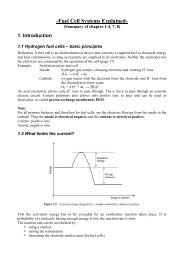Chapter 8. ORGANIC SOLAR CELLS - from and for SET students
Chapter 8. ORGANIC SOLAR CELLS - from and for SET students
Chapter 8. ORGANIC SOLAR CELLS - from and for SET students
Create successful ePaper yourself
Turn your PDF publications into a flip-book with our unique Google optimized e-Paper software.
<strong>SOLAR</strong> <strong>CELLS</strong> <strong>Chapter</strong> <strong>8.</strong> Exciton solar cells<br />
<strong>8.</strong>4.5. Charge collection<br />
The collection of charge carriers at the electrodes is regularly accomplished by a transparent<br />
conductive oxide (TCO) such as ITO or SnO2:F on one side <strong>and</strong> a metal contact on the other<br />
side. Care has to be taken that an Ohmic contact between the electrodes <strong>and</strong> the molecular<br />
layers is <strong>for</strong>med. In practice special contact layers have been developed to obtain better<br />
per<strong>for</strong>mance of the solar cell. Examples of contact layers are a PEDOT:PSS layer, which is a<br />
charged conducting polymer layer at the TCO side <strong>and</strong> LiF layers at the metal contact. The<br />
exact reason how these layers improve the cells is unclear.<br />
For IPV cells the VOC is limited by the electrostatic potential at the junction (see<br />
<strong>Chapter</strong> 4). For organic solar cells reasonable open circuit voltages have been measured <strong>for</strong><br />
cells build up by using a single photoactive molecular material <strong>and</strong> identical electrodes. From<br />
this observation it is evident that the VOC is determined by other factors than <strong>for</strong> an IPV cell.<br />
For an organic solar cell based on two molecular materials as depicted in Figure <strong>8.</strong>4 optical<br />
excitation leads to the <strong>for</strong>mation of an exciton in one of the layers. For the charge separation<br />
process part of the original energy of the photon is lost, yielding an electron in the n-type<br />
material <strong>and</strong> a positive charge carrier in the p-type material. In case there is no potential loss<br />
at the electrodes the maximum observed potential can be obtained by as shown schematically<br />
in Figure <strong>8.</strong>7:<br />
VOC = Ionisation potential of the p-type material – electron affinity of the n-type layer<br />
In practice a potential loss at the electrodes in the order of 0.2 V is often observed.<br />
Figure <strong>8.</strong>7. Energy levels involved in determining the maximum potential generated by an<br />
exciton solar cell. The offset in the energy levels corresponding to LUMO <strong>for</strong>ms the driving<br />
<strong>for</strong>ce <strong>for</strong> the dissociation of the exciton.<br />
-<strong>8.</strong>10-






